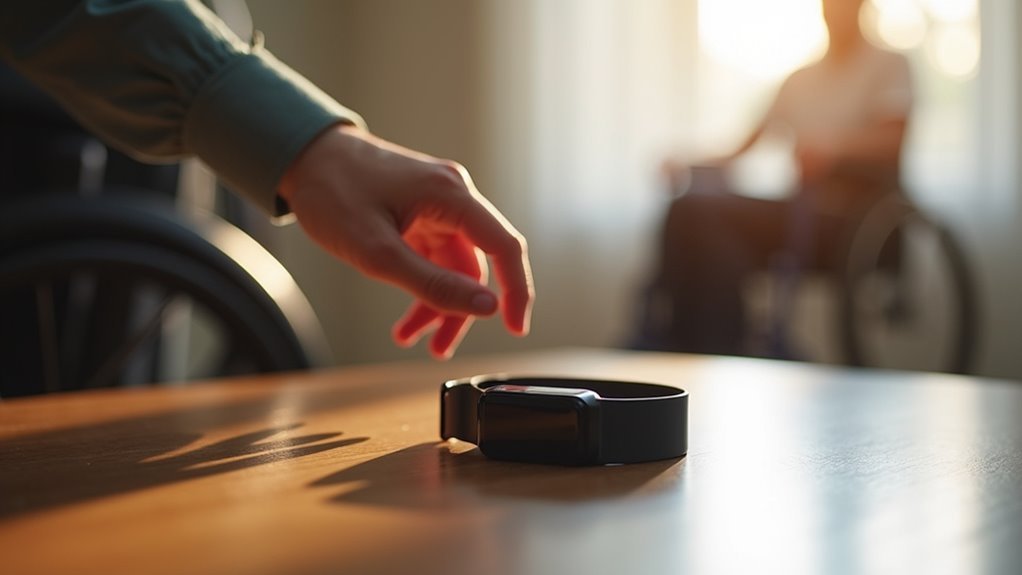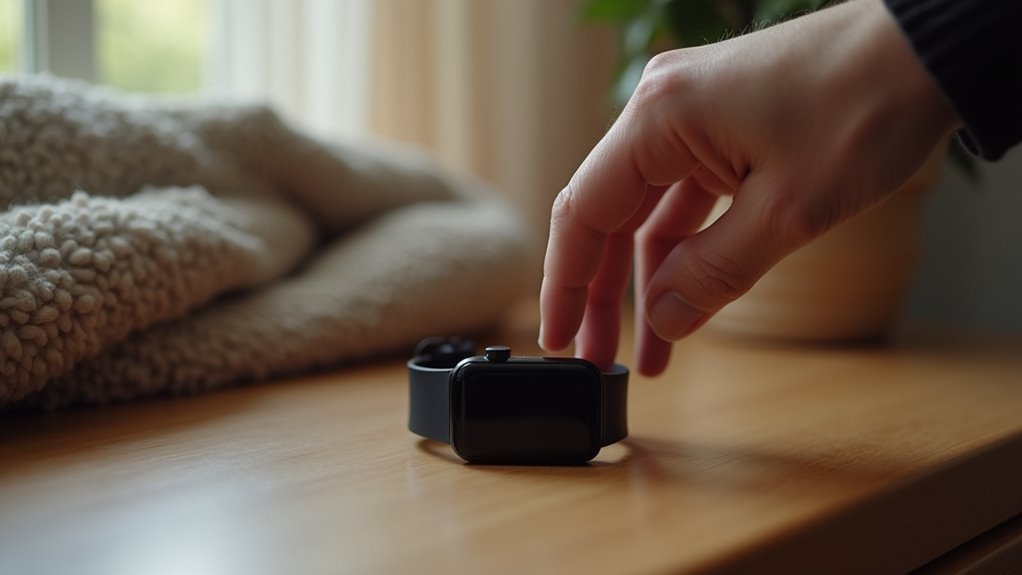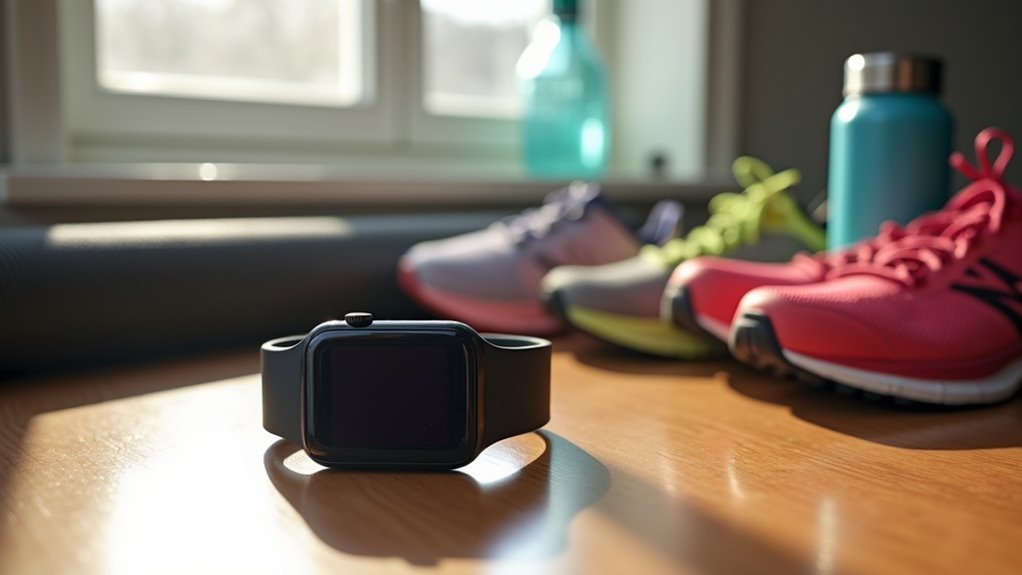Voice commands transform your wearable technology experience by eliminating the need to physically interact with tiny screens or buttons, making your device 15% faster to operate. You’ll access health data, control smart home systems, and communicate hands-free while exercising or working. Advanced AI analyzes your voice patterns for stress detection and provides real-time health insights, while secure voice authentication protects your data with 97% accuracy. Explore how these innovations reshape your daily interactions.
Hands-Free Operation Revolutionizes Daily Interactions

As wearable technology becomes increasingly sophisticated, voice commands are transforming how you interact with devices throughout your day.
You’ll find that 71% of wearable device owners anticipate more frequent voice searches, reflecting growing optimism toward hands-free interaction. Voice commands let you perform tasks without physically touching devices, enhancing convenience during multitasking or physical activity.
You won’t need to remove gloves, handle devices, or disrupt other activities, improving accessibility across diverse situations. With 65% of consumers appreciating the multitasking capabilities of voice devices, wearables become even more valuable for managing daily routines efficiently.
Voice operation delivers faster, more natural control compared to manual navigation on small screens. Whether you’re exercising, driving, or working with your hands busy, voice commands eliminate physical barriers while maintaining seamless device functionality.
This hands-free approach revolutionizes daily interactions by prioritizing efficiency and accessibility.
Enhanced Health Monitoring Through Voice Integration
You can now track your essential signs simply by speaking to your wearable device, transforming how you monitor your health throughout the day.
Your smartwatch or fitness tracker responds to voice commands to measure heart rate, sleep patterns, and oxygen levels without requiring you to touch any buttons or screens.
AI technology analyzes your voice tone alongside these essential signs to detect early signs of stress and anxiety before they become serious health concerns.
These voice-enabled wearables contribute to the growing trend of voice IoT healthcare devices that are revolutionizing personal health management.
Voice-Activated Vital Tracking
When your smartwatch or fitness tracker responds to voice commands, it transforms from a passive monitoring device into an active healthcare partner that delivers real-time essential sign data without requiring you to stop what you’re doing.
You can simply ask for your heart rate, oxygen saturation, or respiratory rate while exercising, working, or caring for others.
AI algorithms process your biometric data instantly, alerting you to abnormalities through voice feedback. This hands-free approach proves especially significant for healthcare professionals who need immediate access to patient indicators during rounds without interrupting care tasks.
Voice-activated devices like Baxter’s Voalte Linq demonstrate how seamless data integration enhances response times while maintaining focus on critical activities. Such technology addresses the communication failures that have been identified in over 60% of sentinel events in healthcare settings.
AI Stress Detection
Beyond monitoring basic essential signs, your wearable device’s AI capabilities extend to detecting stress through sophisticated analysis of physiological signals like heart rate variability, skin conductance, and breathing patterns.
Machine learning algorithms continuously analyze these biomarkers to identify stress patterns in real-time, providing objective monitoring without relying on subjective self-reports. This approach addresses the growing need for noninvasive stress assessment tools that overcome the limitations of traditional questionnaire-based methods.
Voice integration enhances this advanced stress detection by offering:
- Hands-free activation – Simply say “check my stress levels” to initiate monitoring
- Immediate verbal feedback – Receive instant insights about your current stress state
- Voice-guided coping suggestions – Get personalized stress management recommendations through audio prompts
- Seamless smart ecosystem integration – Voice commands trigger wellness routines and reminder systems
This combination enables early intervention and personalized stress management strategies.
Streamlined Workplace Communication and Efficiency

As voice-controlled wearables transform modern workplaces, they’re fundamentally reshaping how teams communicate and operate across industries. You’ll experience rapid information exchange that replaces outdated walkie-talkies and overhead announcements, enabling instant connectivity between team members.
These devices streamline your interactions with management while dramatically reducing response times during emergencies.
You’ll benefit from hands-free operations that boost productivity, allowing you to complete tasks faster without physically handling devices. Voice commands provide real-time access to critical data, while automated routine tasks free you to focus on complex operations. Companies are recognizing this potential, with 86% plan to increase spending on wearable technology in the next 12 months.
Your workplace becomes safer through real-time hazard alerts, proximity detection, and biometric monitoring that tracks fatigue levels. Advanced sensor technology integrates seamlessly with existing systems, providing data-driven insights that optimize resource allocation and enhance overall operational efficiency.
Advanced Security With Voice Authentication Systems
You’ll find that WearID authentication technology revolutionizes how your wearable devices verify your identity by capturing voice vibrations and comparing them across both audio and vibration domains.
This system protects you against replay and impersonation attacks while providing real-time verification of your voice commands.
Your privacy stays secure through advanced protection methods that guarantee only legitimate users can access sensitive features and data on your wearable devices. The system creates comprehensive profiles by analyzing dynamic features like speech rate, accent, and pronunciation nuances that contribute to your unique voice identification.
WearID Authentication Technology
When traditional passwords and PINs become impractical on tiny wearable screens, WearID authentication technology transforms your voice into a secure digital key. You’ll experience hands-free security that analyzes your unique vocal characteristics, eliminating typing struggles on smartwatches or rings.
WearID technology offers four significant advantages:
- Continuous Authentication – Your device monitors voice patterns throughout use, detecting unauthorized access immediately.
- Multi-Modal Security – Voice biometrics combine with heartbeat sensors and device codes for enhanced protection.
- Anti-Spoofing Intelligence – Machine learning algorithms detect synthesized or recorded voice attacks automatically.
- Adaptive Recognition – The system adjusts to natural voice changes over time without requiring re-enrollment.
You’ll find WearID particularly valuable in professional settings where workflow interruptions aren’t tolerable, while noise-cancellation technology guarantees reliable performance across various environments. Voice patterns ensure that even known passwords cannot be mimicked by potential attackers attempting unauthorized access.
Privacy Protection Methods
While voice authentication streamlines wearable interactions, protecting your privacy requires sophisticated multi-layered security protocols that go far beyond simple voice recognition.
| Security Feature | Protection Method | Effectiveness Rate |
|---|---|---|
| VAuth Technology | Audio + vibration signals | 97% accuracy |
| Replay Attack Defense | Signal consistency verification | <0.1% false positives |
| Accelerometer Data | Unique vibration patterns | Real-time verification |
| Multi-Modal Authentication | Combined biometric verification | Enhanced fraud protection |
| Cloud Integration | Advanced analysis algorithms | Continuous monitoring |
You’ll benefit from systems that combine your voice’s audio signals with vibrations detected by your wearable device. This unique approach thwarts impersonation attempts, replay attacks, and mangled voice fraud by verifying consistency between what’s heard and felt. Your device becomes a personal identity token that works across different languages and accents while maintaining mobility. The technology is available as different wearable formats including necklaces, ear buds, and eyeglasses attachments to suit various user preferences and lifestyles.
Accessibility Features for Users With Disabilities

As technology advances rapidly, voice commands in wearable devices have become crucial accessibility features that transform how users with disabilities interact with their devices.
You’ll find these innovations break down barriers and create more inclusive digital experiences.
Voice commands offer several key accessibility benefits:
- Hands-Free Control – You can navigate your device without physical touch, perfect for motor impairments.
- Real-Time Navigation – You’ll receive audio directions and location assistance for mobility challenges.
- Independent Health Monitoring – Your device tracks essential signs and alerts you to potential health risks.
- Enhanced Communication – You can access language translation and audio amplification features.
The development of industry standards ensures seamless integration across different wearable devices and platforms.
With 14.6% of individuals with disabilities already using wearables, you’re witnessing a significant shift toward inclusive technology that empowers independence and improves quality of life.
AI-Powered Personalized Health Insights
Voice commands now serve as the gateway to something even more revolutionary: AI-powered systems that transform your wearable device into a personalized health advisor.
Simply ask your device about your sleep patterns, and it’ll analyze weeks of data to recommend ideal bedtime routines. Request stress insights, and machine learning algorithms instantly identify triggers from your heart rate variability and environmental factors.
Your wearable doesn’t just collect metrics—it predicts potential health issues before symptoms appear. AI creates custom risk profiles based on your unique patterns, alerting you to irregular heart rhythms or metabolic changes.
You’ll receive real-time recommendations for exercise, nutrition, and stress management tailored specifically to your current health status, empowering you to make informed decisions about your wellbeing. Modern wearables have moved beyond basic activity tracking to provide comprehensive health monitoring that transforms how we understand our bodies.
Real-Time Stress Detection and Management
When stress peaks during your workday, your wearable device doesn’t wait for you to notice—it’s already analyzing your heart rate variability, electrodermal activity, and breathing patterns to identify the exact moment tension begins building in your body.
Machine learning algorithms process this continuous data stream, achieving up to 96% accuracy in stress detection through fuzzy logic and decision trees. Your device immediately suggests personalized interventions based on your physiological state. Unlike traditional stress assessments that rely on questionnaires and interviews, wearable devices eliminate the subjective bias that often compromises accurate stress evaluation.
Voice commands make stress management effortless when you need it most:
- Request instant stress assessments without touching your device
- Access guided breathing exercises through simple voice prompts
- Receive personalized relaxation techniques tailored to your current stress level
- Get real-time feedback on your physiological responses during interventions
This seamless integration transforms reactive stress management into proactive wellness support.
Remote Patient Monitoring Capabilities
Remote patient monitoring transforms from a cumbersome process of manual data entry and scheduled check-ins into an intuitive conversation between you and your wearable device.
You’ll input symptoms and medication adherence simply by speaking, while biosensors automatically record your essential signs hands-free. This streamlined approach reduces errors and improves data reliability for your healthcare team.
Your wearable provides vocal alerts for abnormal readings and medication reminders, enabling faster clinical responses.
If you’re elderly, disabled, or have limited mobility, voice commands eliminate touchscreen barriers and promote independence at home.
Healthcare providers access your data through voice-enabled dashboards, reducing their documentation burdens. The continuous data collection enables predictive analytics that help identify potential health issues before they become critical.
This scalable system allows monitoring more patients simultaneously while lowering costs and supporting chronic disease management effectively.
Boosted Productivity Through Voice-Activated Workflows
You’ll find that voice-activated wearables transform your workplace by eliminating communication bottlenecks and enabling instant information exchange between team members.
These devices streamline your daily operations through hands-free task management, allowing you to prioritize critical activities without constant device interruptions. Voice commands through smart eyewear enable seamless integration with virtual meeting platforms and real-time augmented reality overlays for enhanced training capabilities.
You’re able to optimize your time allocation as the wearables provide real-time productivity metrics and automate routine scheduling tasks.
Streamlined Workplace Communication
As voice-activated technology transforms how professionals interact with workplace systems, you’re witnessing a fundamental shift toward more efficient communication workflows.
Voice-enabled solutions eliminate barriers between your thoughts and digital output, creating seamless interactions that boost responsiveness and decision-making capabilities.
Here’s how voice commands streamline your workplace communication:
- Real-time CRM updates – Update lead status, document meeting notes, and check customer details instantly without manual typing.
- Hands-free multitasking – Execute multiple tasks concurrently while dictating emails or reports to mobile workers.
- Voice-activated data entry – Reduce manual errors and enhance operational efficiency through seamless voice-driven system interactions.
- Automated workflow triggers – Activate AI-enabled processes and receive voice alerts for streamlined operations.
You’ll save hours weekly while improving accuracy and operational efficiency. Advanced neural networks continuously analyze your speech patterns to deliver increasingly precise transcription results across different workplace scenarios.
Enhanced Time Management
When voice-activated wearables replace manual input methods, you’re transforming scattered time fragments into productive workflows that compound throughout your workday. Voice commands eliminate complex menu navigation, saving precious seconds that accumulate into significant productivity gains. You’ll automate routine reminders, schedules, and notifications while maintaining focus on primary tasks.
| Traditional Method | Voice Command | Time Saved |
|---|---|---|
| Navigate settings menu | “Adjust volume to 50%” | 8 seconds |
| Type task updates | “Mark project complete” | 12 seconds |
| Search for contacts | “Call warehouse manager” | 15 seconds |
| Manual scheduling | “Schedule meeting tomorrow 2pm” | 20 seconds |
| Device switching | “Switch to headset audio” | 6 seconds |
You’ll experience 15% faster operations through voice-driven automation, enabling real-time task prioritization without interrupting workflow continuity. The intuitive design of wearables significantly reduces training time required for new users to become proficient.
Privacy Protection in Voice Command Processing
While voice commands offer unprecedented convenience in wearable technology, they also create significant privacy vulnerabilities that require thorough protection strategies.
You’ll need robust safeguards to protect your sensitive voice data from unauthorized access and misuse.
Essential privacy protection measures include:
- End-to-end encryption – Your voice data gets encrypted during transmission and storage, preventing interception by cybercriminals.
- Local processing – Commands process directly on your device, reducing data transmission risks and keeping information private.
- Informed consent protocols – You maintain complete control over your data collection preferences and usage permissions.
- Regular security audits – Continuous penetration testing identifies vulnerabilities before they’re exploited.
You should also guarantee GDPR compliance and implement two-factor authentication for maximum protection against voice identity theft and unauthorized data sharing. Regulatory frameworks like GDPR provide essential governance for personal data handling, though implementation standards may vary across different wearable device manufacturers.
Seamless Integration With Smart Home Ecosystems
Your voice-enabled wearable becomes the central command hub that transforms how you interact with your entire smart home ecosystem. With 72% of people using voice-activated speakers daily, your smartwatch seamlessly bridges the gap between wearable technology and home automation.
Your smartwatch transforms into mission control for your entire home, creating seamless voice-powered automation that responds instantly to your commands.
You’ll control lights, thermostats, and security systems through simple voice commands, eliminating the need for multiple apps or physical remotes.
Cross-platform compatibility guarantees your wearable works across different operating systems, creating unified control regardless of your device preferences. Over 70% of devices will support seamless integration by 2025, making your home automation experience more intuitive.
Your wearable’s hands-free functionality lets you adjust home settings while cooking, exercising, or multitasking, creating a truly personalized living environment that responds to your voice. The market’s focus on practical improvements rather than revolutionary shifts ensures these technologies enhance everyday living experiences without disrupting your established routines.
Future Developments in Wearable Voice Technology
The voice technology powering today’s wearables represents just the beginning of a revolutionary transformation that’ll reshape how you interact with these devices.
As generative AI advances, you’ll experience more lifelike, adaptive responses that make conversations feel natural and intuitive.
Future developments will deliver:
- Proactive health coaching – Your device will suggest personalized fitness plans and stress management techniques before you even ask.
- Enhanced hardware miniaturization – Smaller, more comfortable wearables with multi-microphone arrays for superior voice recognition in any environment.
- Real-time biometric alerts – Voice notifications about early fatigue, dehydration, or stress detection through advanced sensor integration.
- Secure on-device processing – Privacy-focused voice processing that keeps your sensitive health data protected locally.
Voice commands will also enable gesture controls for intuitive device interaction, particularly through next-generation smart rings that combine minimal design with powerful functionality.
You’ll soon enjoy hands-free experiences that anticipate your needs while maintaining complete data security.
Frequently Asked Questions
How Long Does the Battery Last When Using Voice Commands Frequently?
When you’re using voice commands frequently, your battery life drops considerably. You’ll get 1-3 days from smartwatches, while fitness bands might last weeks, depending on your device’s power management features.
Can Voice Commands Work Properly in Noisy Environments or Outdoors?
Voice commands struggle in noisy environments like traffic or crowds. Steady background sounds affect accuracy less than variable noise. However, newer systems with robust technology can maintain 90% accuracy despite challenging outdoor conditions.
What Happens if My Voice Changes Due to Illness or Aging?
Your wearable device can adapt to voice changes through machine learning algorithms. It’ll learn your new patterns over time, though you might need to retrain it initially when illness or aging markedly alters your speech.
Do Voice Commands Require Internet Connectivity to Function Properly?
Voice commands don’t always need internet connectivity. While cloud-based assistants like Siri require online access, you can use offline voice recognition technology that processes commands locally on your device without any internet connection.
How Much Do Voice-Enabled Wearables Cost Compared to Regular Wearables?
You’ll pay $250-$799 for voice-enabled smartwatches compared to under $50-$300 for regular wearables. Voice technology, cellular connectivity, and advanced sensors typically double or triple costs over basic fitness trackers.
In Summary
You’re experiencing a fundamental shift in how you interact with technology. Voice commands don’t just add convenience to your wearables—they’re reshaping everything from health monitoring to workplace productivity. You’ll find yourself completing tasks faster, staying safer with authentication features, and accessing technology regardless of physical limitations. As these systems become more sophisticated, you’re not just wearing technology—you’re living seamlessly within an integrated voice-powered ecosystem that anticipates your needs.





Leave a Reply